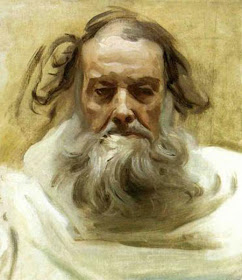 image from artrenewal.org
image from artrenewal.orgThe next quality I want to point out in Sargent is his ability to express the planar structure in his subjects. Most portrait painters do this, but Sargent does it particularly well and with great clarity. Look at the head above, particularly at the malar surfaces of the zygomatic processes
(the frontward facing planes of that cage of bone surrounding the eye) and the deep shadows beneath the supraorbital eminences ( above the eyes, for crying out loud ). Sargent has chopped these out as if with an axe. He is seizing on and explaining carefully the forms by reducing them in a simplified and sculptural way. He portrays how the structures might seem if we ran our fingers over them as much as looked at them. This is extracted from nature, and amplified by his understanding of the anatomical structure laying beneath the flesh.
I am fond of saying that various qualities cannot be observed into a painting. In this case that may not be exactly true, this is heightened observation informed by an understanding of the surfaces portrayed and their angle of inclination toward the light source. It is an amplified form of observation.
Because form is not simply observed from nature, but installed by the artists decision making processes, two things then follow. They are;
- The creation of form in a painting is art,unlike mere transcription. Art is always the product of decision making and thought, not accident or mechanical transcription.
- Because different artists make different decisions on how to handle form, their work varies in its treatment, therefore decision making about form is an element off style. How Sargent chooses to define form is different stylistically from how Thomas Hart Benton would.
 Here is our little girl again, and below I have enlarged the head and exaggerated the highlighted planes beside the eye and about the muzzle.
Here is our little girl again, and below I have enlarged the head and exaggerated the highlighted planes beside the eye and about the muzzle. These planes face the light more than the other planes of the face and Sargent has explained the thrust of the forms of the face using them. They show the angle at which the face moves through space towards us. He is sculpting the face as a three D object rather than carefully transcribing flat shapes that hopefully will assemble in the viewers eye and make us believe the solidity of the forms. The inability to emphatically explain form is the inherent weakness of purely visual draftsmanship.
These planes face the light more than the other planes of the face and Sargent has explained the thrust of the forms of the face using them. They show the angle at which the face moves through space towards us. He is sculpting the face as a three D object rather than carefully transcribing flat shapes that hopefully will assemble in the viewers eye and make us believe the solidity of the forms. The inability to emphatically explain form is the inherent weakness of purely visual draftsmanship.I have written other posts on form, some of them are here, here and here.
Thank you very much for these posts they are fantastic. I really appreciate the depth. Please continue on with these posts!
ReplyDeletei do enjoy reading and learnign from your posts. i was wondering if you could possibly show example paintings where things have not been effective as a comparison?
ReplyDeleteThese posts are invaluable for our art knowledge- thank you! I know it will take much work before I can utilize this information, but I know I'm heading in the right direction if I can begin to understand these concepts.
ReplyDeleteHa! Stape! Chopped out as if with an axe:)(I won't even go there)
ReplyDeleteI see what you mean though, each stroke should serve a purpose.
I don't quite understand the stroke against/with the form thing?
Are we trying to create an illusion
of 3 dementional by doing this?
Thanks Stape! This is great!
Charles;
ReplyDeleteThanks,
.......Stape
rahina;
ReplyDeleteIt is easy to find photos of great art. If I use photos of amateur art it will probably wound the creators.
.....................Stape
Judy;
ReplyDeleteI have a new concept tonight.
..................Stape
Bill:
ReplyDeleteGenerally it is best to place a stroke across the form, although that is by no means a rule or a constant. I have written a blog post on this. It is in the archives, God knows where.
.............Stape